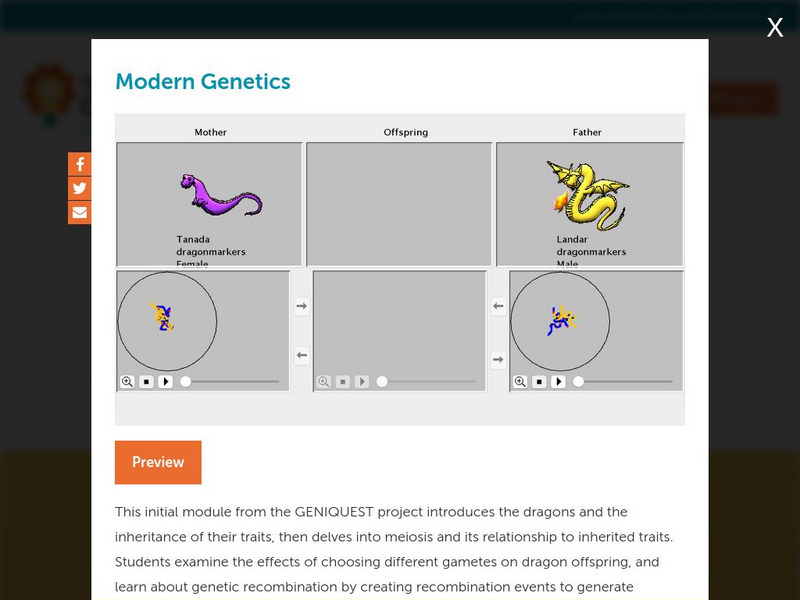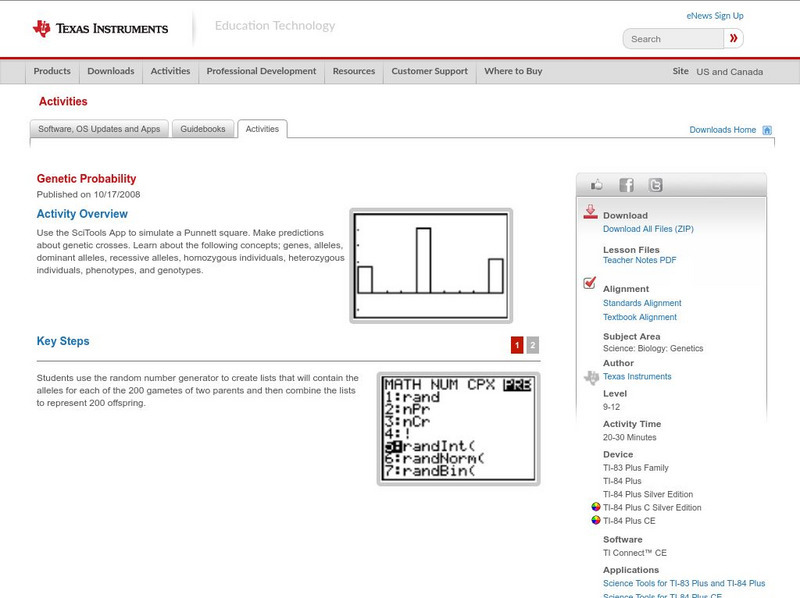Cold Spring Harbor Laboratory
Dna From the Beginning: Genes Come in Pairs
This animated lesson will explain how genes are inherited in pairs, one from the mother and one from the father.
Khan Academy
Khan Academy: Multiple Alleles, Incomplete Dominance, and Codominance
In the real world, genes often come in many versions (alleles). Alleles aren't always fully dominant or recessive to one another, but may instead display codominance or incomplete dominance.
Khan Academy
Khan Academy: Allele Frequency & the Gene Pool
Learn how to find allele frequency and how it's different from genotype frequency.
The Association of the British Pharmaceutical Industry
Abpi: Genes and Inheritance
A complete, student-paced lesson on genetics and inheritance. Students work their way through illustrations and animated tutorials, and answer review questions along the way. There is a self-checking quiz at the end of the lesson.
Other
Univ. Of Connecticut: Hardy Weinberg Principle and Estimating Allele Frequencies
This site from the University of Connecticut is Kent Holsinger's site on The Hardy-Weinberg Principle. A great site to check out on the subject, with links to additional information, including: derivation of the Hardy-Weinberg Principle,...
Khan Academy
Khan Academy: Variations on Mendel's Laws (Overview)
Article reviews Mendel's basic model of inheritance then provides an overview of variations on Mendel's laws, including multiple alleles, incomplete dominance, co-dominance, pleiotropy, lethal alleles, sex linkage, genetic interactions,...
CK-12 Foundation
Ck 12: Episd: Mendel's Laws and Genetics
[Free Registration/Login may be required to access all resource tools.] Explore the genetics research conducted by biologist Gregor Mendel and understand the significance of alleles on genes.
Nature Research
Scitable: Population and Quantitative Genetics
Do you know the difference between population genetics and quantitative genetics? This webpage examines both population genetics which concentrates on frequencies of alleles and genotypes and quantitative genetics which deals with the...
Khan Academy
Khan Academy: Natural Selection in Populations
How natural selection works at the level of genes, alleles, genotypes, & phenotypes.
Cold Spring Harbor Laboratory
Dna From the Beginning: Some Genes Are Dominant
Learn about the principle of dominance as you watch animations showing Mendel's experiments with pea plants. Find out what happened when he crossed plants that produced green seeds with those that produced yellow seeds.
BBC
Bbc: Gcse Bitesize: Genetic Inheritance
This lesson focuses on genetic inheritance including defining key terms such as chromosomes, alleles, DNA, genes, genome, and more. Links to a video and a test are provided.
Oklahoma State University
Oklahoma State University: Ag in the Classroom: Hairy Heredity [Pdf]
A simulation where students flip coins to mimic how parents pass genetic traits to their offspring through heredity. This activity also illustrates the difference between dominant and recessive genes, and how they interact with each...
BiologyWise
Biology Wise: Dominant and Recessive Traits in Humans
Explains what dominant and recessive traits are and how they work, and provides a list of single gene traits with the degree of manifestation if they are dominant or recessive. Also discusses co-dominance, incomplete dominance, polygenic...
TeachEngineering
Teach Engineering: What's Dominant?
In a class discussion format, the teacher presents background information about basic human genetics. The number of chromosomes in both body cells and egg and sperm cells is covered, as well as the concept of dominant and recessive...
Concord Consortium
Concord Consortium: Stem Resources: Modern Genetics
Try your hand at mating dragons to learn about genetic recombination, meiosis, and inherited traits. Understand how chromosomes separate in meiosis with a science animation. Then change alleles for the dragons to see what happens to...
Ducksters
Ducksters: Biology for Kids: Hereditary Patterns
A site with information about the hereditary patterns in the science of biology including dominant and recessive genes, alleles, the Punnet square, examples, and interesting facts.
Texas Instruments
Texas Instruments: Genetic Probably
Activity Overview Use the SciTools App to simulate a Punnett square. Make predictions about genetic crosses. Learn about the following concepts; genes, alleles, dominant alleles, recessive alleles, homozygous individuals, heterozygous...
University of Arizona
The Biology Project: Genetic Drift: An Explanation
This explanation of genetic drift is straightforward and easy to understand. Illustrations are provided to help visual learners
University of Hamburg
University of Hamburg: Deviations From Mendelian Laws And: What Is the Meaning of Dominance?
Upper level discussion of several of Mendel's experiments and laws.
Nobel Media AB
The Nobel Prize: Thomas Hunt Morgan and His Legacy
This detailed article from the Nobel e-Museum explores Thomas Hunt Morgan's career and research in genetics. Read how Morgan's work influenced later scientists and the modern scientific world.
Other
Evolution: The Theory of Natural Selection (Part 1)
These pages are part of a site called Evolution that accompany a textbook by the same name. Mark Ridley is the author. This section has an advanced discussion of determining allele and genotype frequencies using the Hardy-Weinberg ratio.
Science Buddies
Science Buddies: X Inactivation Marks the Spot for Cat Coat Color
A tortoiseshell cat has two different fur colors, black or brown and red or orange. The gene that gives rise to the red or orange fur color is on the X chromosome. Female cats have two X chromosomes, while males only have one, which...
Other
University of Connecticut: Genetic Drift
A Java simulation of genetic drift where users can select a starting allele frequency, population size, and a maximum number of generations. Simulation gives a graph that shows allele frequency versus generation number.
PBS
Pbs: How Does Evolution Work?: Breeding Bunnies
This resource provides directions for a lab in which students observe changes in a gene pool of bunnies affected by natural selection. Includes PDF resources.

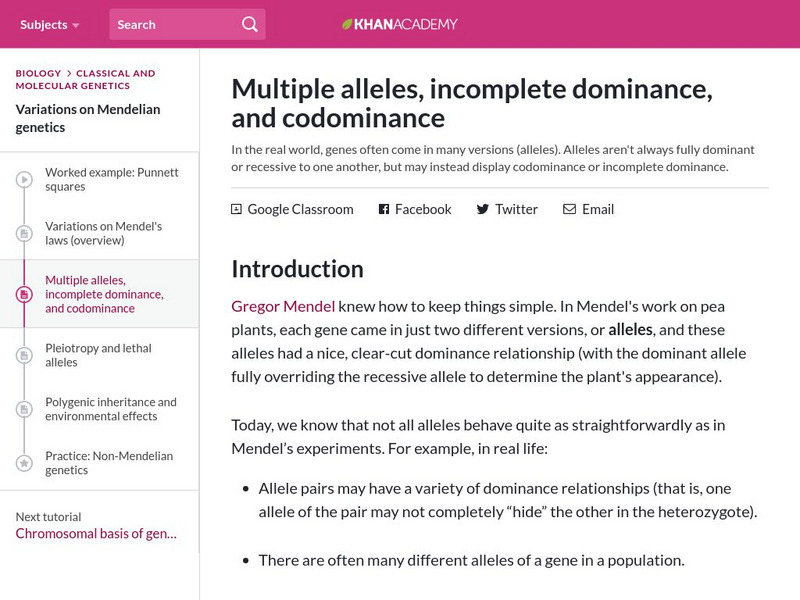



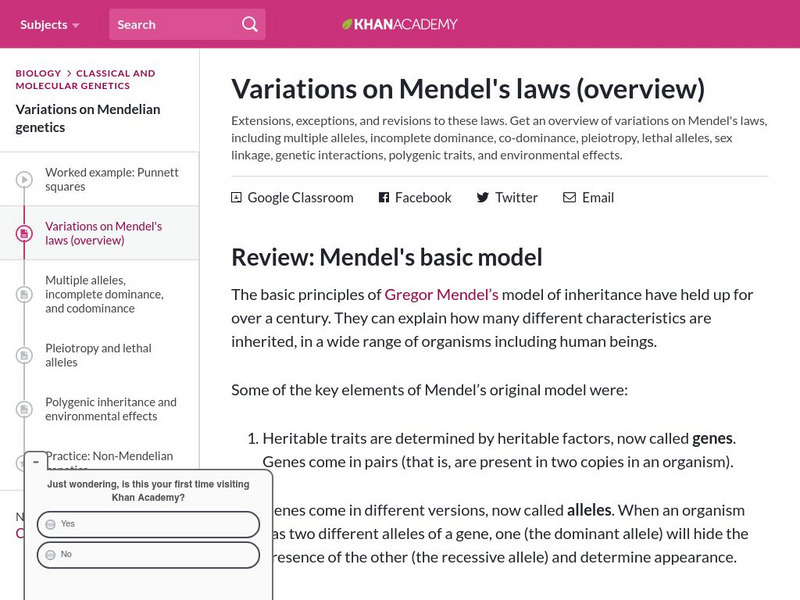


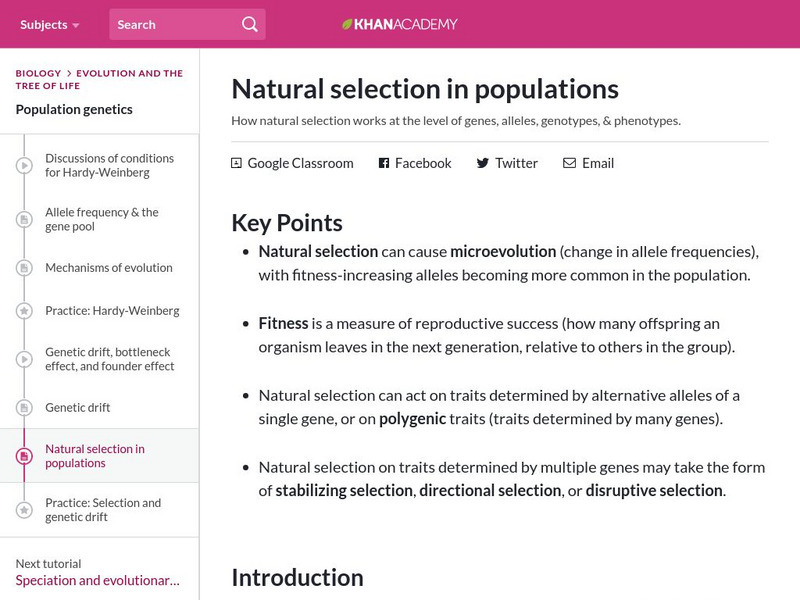


![Oklahoma State University: Ag in the Classroom: Hairy Heredity [Pdf] Activity Oklahoma State University: Ag in the Classroom: Hairy Heredity [Pdf] Activity](https://d15y2dacu3jp90.cloudfront.net/images/attachment_defaults/resource/large/FPO-knovation.png)

